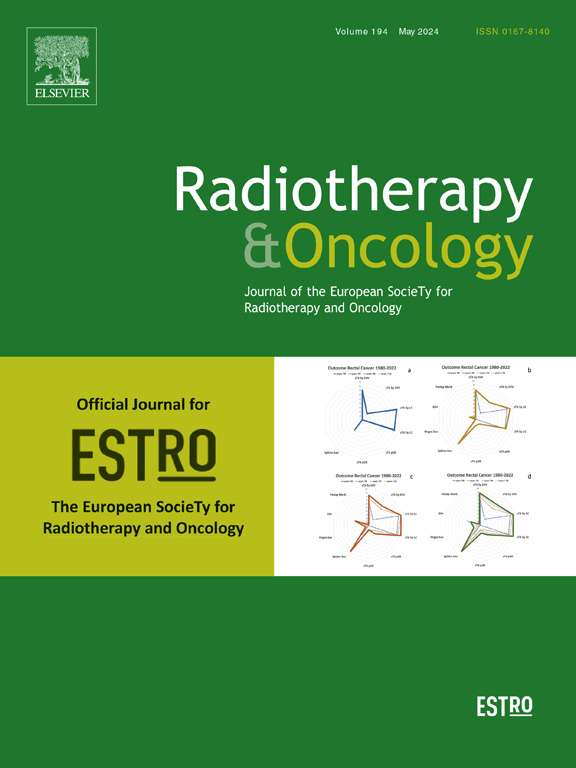Presentation and outcomes of second primary malignancies (SPMs) in locally advanced oral cavity squamous carcinoma (LA-OSCC): Secondary analysis of a phase III randomised control trial (NCT00193843)
IF 4.9
1区 医学
Q1 ONCOLOGY
引用次数: 0
Abstract
Background
Second Primary Malignancies (SPMs) are a common cause of morbidity and mortality in Head & Neck Squamous Carcinoma (HNSCC). Prospective data on incidence, outcomes and prognostic factors is sparse. The current publication summarizes data on 83 SPMs which developed on follow up among patients accrued on a Phase III Randomized Controlled Trial testing treatment intensification in Oral Cavity Squamous Carcinoma (OSCC).
Patients and Methods
Nine hundred patients of OSCC accrued between 2005–2013 were followed up as part of the trial protocol. Standard clinical criteria were used to determine SPM occurrence. Clinicopathological and demographic variables were summarized using descriptive statistics and analysed using measures of central tendency and dispersion. Outcomes of interest included Overall-Survival (OS) and Progression-Free-Survival (PFS) post SPM diagnosis and were analysed using the Kaplan-Meier method and factors of prognostic significance were compared using the log-rank test and multivariate analysis thereafter.
Results
The median follow-up of surviving patients was 95.9 months {(IQR) = 76.1–122.4 months}. A total of 83 SPMs were detected at a median time-to-occurrence of 48 months (IQR-20–87 months) (Cumulative Incidence −11 % at 5 years). The Head & Neck was the most common site of SPM. The 2-year Kaplan Meier estimates of OS and PFS post diagnosis of SPM were 30.3 % (95 %CI-20.9 %-43.9 %) and 21.6 % (95 %CI-13.8 %-34 %) respectively. Multivariate analysis revealed time-to-development of SPM more than 2 years and surgical management of SPM to be associated with superior PFS.
Conclusions
SPMs can cause major morbidity and mortality in OSCC survivors. Strategies need to be developed to gear towards early detection and aggressive salvage.
局部晚期口腔鳞状癌(LA-OSCC)中第二原发恶性肿瘤(SPMs)的表现和结局:一项III期随机对照试验的二次分析(NCT00193843)
背景:第二原发恶性肿瘤(SPMs)是头部发病和死亡的常见原因。颈部鳞癌(HNSCC)。关于发病率、结局和预后因素的前瞻性数据很少。目前的出版物总结了83例SPMs的数据,这些SPMs是在口腔鳞状癌(OSCC)治疗强化的III期随机对照试验中累积的患者中随访产生的。作为试验方案的一部分,研究人员对2005-2013年期间积累的900例OSCC患者进行了随访。采用标准临床标准确定SPM的发生。临床病理和人口学变量用描述性统计进行总结,用集中趋势和离散度进行分析。关注的结果包括SPM诊断后的总生存期(OS)和无进展生存期(PFS),并使用Kaplan-Meier方法进行分析,之后使用log-rank检验和多变量分析比较预后显著性因素。结果存活患者中位随访时间为95.9个月{(IQR) = 76.1-122.4个月}。共检测到83例spm,中位发病时间为48个月(IQR-20-87个月)(5年累积发病率- 11%)。头部&;颈部是最常见的SPM部位。SPM诊断后的2年Kaplan Meier估计OS和PFS分别为30.3% (95% ci - 20.9% - 43.9%)和21.6% (95% ci - 13.8% - 34%)。多因素分析显示,SPM的发病时间超过2年,SPM的手术治疗与较好的PFS相关。结论spms在OSCC存活患者中具有重要的发病率和死亡率。需要制定战略,以便尽早发现和积极抢救。
本文章由计算机程序翻译,如有差异,请以英文原文为准。
求助全文
约1分钟内获得全文
求助全文
来源期刊

Radiotherapy and Oncology
医学-核医学
CiteScore
10.30
自引率
10.50%
发文量
2445
审稿时长
45 days
期刊介绍:
Radiotherapy and Oncology publishes papers describing original research as well as review articles. It covers areas of interest relating to radiation oncology. This includes: clinical radiotherapy, combined modality treatment, translational studies, epidemiological outcomes, imaging, dosimetry, and radiation therapy planning, experimental work in radiobiology, chemobiology, hyperthermia and tumour biology, as well as data science in radiation oncology and physics aspects relevant to oncology.Papers on more general aspects of interest to the radiation oncologist including chemotherapy, surgery and immunology are also published.
 求助内容:
求助内容: 应助结果提醒方式:
应助结果提醒方式:


